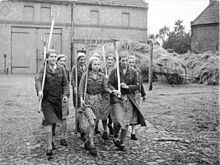League of German Girls
Bund Deutscher Mädel | |
youth organization | |
| Legal status | Defunct, illegal |
|---|---|
| Location | |
Region served | Nazi Germany |
Official language | German |
| Leader | Baldur von Schirach Trude Mohr Jutta Rüdiger |
Parent organization | Hitler Youth |
| Affiliations | Nazi Party |
The League of German Girls or the Band of German Maidens[1] (German: Bund Deutscher Mädel, abbreviated as BDM) was the girls' wing of the Nazi Party youth movement, the Hitler Youth. It was the only legal female youth organization in Nazi Germany.
At first, the League consisted of two sections: the Jungmädelbund ("Young Girls' League") for girls aged 10 to 14, and the League proper for girls aged 14 to 18. In 1938, a third section was introduced, the BDM-Werk Glaube und Schönheit ("Faith and Beauty Society"), which was voluntary and open to girls between the ages of 17 and 21.
Due to the compulsory membership of all young women, except for those excluded for racial reasons, the League became the largest female youth organization at the time with over 4.5 million members.
With the surrender of Nazi Germany in 1945, the organization de facto ceased to exist. On 10 October 1945, it was outlawed by the Allied Control Council along with other Nazi Party organizations. Under Section 86 of the German Criminal Code, the Hitler Youth is an "unconstitutional organization" and the distribution or public use of its symbols, except for educational or research purposes, is not permitted.
| Part of a series on |
| Nazism |
|---|
 |
History
The Bund Deutscher Mädel had its roots in the early 1920s, in the first Mädchenschaften or Mädchengruppen, also known as Schwesternschaften der Hitler-Jugend (Sisterhood of the Hitler Youth). In 1930, the BDM was founded, and in 1931 it became the female branch of the Hitler Youth.

Soon after taking office as Reichsjugendführer on 17 June 1933, Baldur von Schirach issued regulations that suspended or forbade existing youth organizations ('concurrence'). Female youth groups were compulsorily integrated into the BDM, which was declared to be the only legally permitted organization for girls in Germany. Many of the existing organizations closed down to avoid this.[6] These Nazi activities were a part of the Gleichschaltung (Equalization) starting in 1933. The Reichskonkordat between the Catholic Church and Nazi Germany, signed on 20 July 1933, gave a certain shelter to the Catholic youth ministry, but they were the object of much bullying.
The Gesetz über die Hitlerjugend (law concerning the Hitler Youth), dated 1 December 1936, forced all eligible juveniles to be a member of HJ or BDM. They had to be ethnic Germans, German citizens, and free of hereditary diseases.[7] Girls had to be 10 years of age to enter this League.
The BDM was run directly by Schirach until 1934, when

As in the HJ, separate sections of the BDM existed, according to the age of participants. Girls between the ages of 10 and 14 were members of the Young Girl's League (
At the beginning of World War II, the
While these ages are general guidelines, there were some exceptions for members holding higher (salaried) leadership positions, starting at the organizational level of "Untergau". As regards lower (honorary) positions, even members of the JM could apply for them after two years of membership and would then obtain such a position typically at the age of 13. The higher leadership was recruited from members over 18 and was expected to maintain salaried office for no more than 10 years, and to leave the BDM by the age of 30.[10] As a general rule, members had to leave when they were married and especially when they had children.
Uniform and emblems

The BDM uniform was a full blue skirt, middy blouse and very heavy marching shoes.[11] In 1939, a new uniform was introduced for regional and national leaders within the League of German Girls, and along with the new uniforms came new rank insignia for leaders. These new rank insignia took the form of a silver, and for higher ranks, gold bullion embroidered open-winged eagle on a black (white, on the summer tunic) shield with various types of borders to indicate grade. They were worn on the left chest of the tunic.[12]
[13] |

|

|

|

|

|

|

|

|

| |
|---|---|---|---|---|---|---|---|---|---|---|
| Reichsreferentin | Gebietsmädelführerin | Gauführerin | Untergauführerin | Hauptmädelführerin | Bannmädelführerin | Ringführerin | Hauptgruppenführerin | Gruppenführerin |
Leaders
Trude Mohr was appointed the first Reichsreferentin in June 1934.[14] Her main initiative was to nourish a new way of living for the German youth, stating:[15]
Our people need a generation of girls which is healthy in body and mind, sure and decisive, proudly and confidently going forward, one which assumes its place in everyday life with poise and discernment, one free of sentimental and rapturous emotions, and which, for precisely this reason, in sharply defined feminity, would be the comrade of a man, because she does not regard him as some sort of idol but rather as a companion! Such girls will then, by necessity, carry the values of National Socialism into the next generation as the mental bulwark of our people.
In 1937, after marrying Obersturmführer Wolf Bürkner,[16] she became pregnant and resigned her duties.[15]
Jutta Rüdiger (1910–2001) was a special case.[17] She joined the BDM only in 1933, at the age of 23 and after having finished her doctorate in psychology. She obtained honorary positions instantly in 1933 and early 1934, was promoted to her first salaried position (leader of Untergau Ruhr-Lower Rhine) in June 1935 and was appointed Reichsreferentin for the BDM (head of the BDM) in November 1937 (aged 27),[18] succeeding Mohr, who had vacated the position on her marriage, as Nazi policy required. She kept this position even until the German defeat, when she reached the age of 34.
Clementine zu Castell-Rüdenhausen (1912–2008), a countess and member of the higher Franconian aristocracy, was appointed leader of Gau Unterfranken in 1933, at the age of 21, which also seems to have been the age when she joined the BDM, as no earlier date of membership nor any previous lower positions are recorded in her case. She was appointed head of "Faith and Beauty" in January 1938, a few days before her 26th birthday, and was discharged in September 1939 because of her marriage with Wilhelm "Utz" Utermann in October 1939. She was followed by an Austrian member, Annemarie Kaspar (b. 1917), who had been appointed Untergauführerin at the age of 20 in March 1938 and became head of B&B two weeks before her 22nd birthday. She too married and was discharged in May 1941, to be replaced in June 1941 by Martha Middendorf (b. 1914), who was 27 at the time of her appointment and was discharged already in February 1942, as she too had married. From this time on, Jutta Rüdiger, who was a lesbian in lifelong partnership with Hedy Böhmer, a fellow Nazi traveller, and thus uninterested in marriage, took over to lead the BDM directly, thus holding both leadership positions until 1945.[19]


Training and activities
The BDM used campfire romanticism, summer camps, folklorism, tradition, and sports to indoctrinate girls within the Nazi belief system, and to train them for their roles in German society: wife, mother, and homemaker.[20][21] Their home evenings revolved around domestic training, but Saturdays involved strenuous outdoor exercise and physical training.[22] The purpose of these activities was to promote good health, which would enable them to serve their people and their country.[23] The "home evenings"—ideally to be conducted in specially built homes—also included world view training, with instruction in history.[24] This instruction would include learning the Horst Wessel song, the Nazi holidays, stories about Hitler Youth martyrs, and facts about their locality and German culture and history.[25] Physical education included track and field sports like running and the long jump, gymnastics (e.g. somersaulting and tightrope walking), route-marching, and swimming.[25] The importance of self-sacrifice for Germany was heavily emphasized; a Jewish woman, reflecting on her longing to join the League of German Girls, concluded that it had been the admonishment for self-sacrifice that had drawn her most.[26] Members were also taught the Nazi Party's racial ideas.[27] The League was particularly regarded as instructing girls to avoid Rassenschande or racial defilement, which was treated with particular importance for young females.[28]
Holiday trips offered by HJ and BDM – for example, skiing in winter and tent camps in summer – were affordable; children from poor families got subsidies. These offers were popular.[29]
The League encouraged rebellion against parents.[30] Der Giftpilz presented the propaganda of a German girl being ordered to visit a Jewish doctor by her mother; the girl protested on the grounds of what she had learned at BDM meetings, and while at the office, remembered the warnings in time to escape being molested by the doctor.[31] She then insisted that her mother admit that the BDM had clearly been in the right.[31]
Ilsa McKee noted that the lectures of Hitler Youth and the BDM on the need to produce more children produced several illegitimate children, which neither the mothers nor the possible fathers regarded as problematic.
The
Before entering any occupation or advanced studies, the girls, like the boys in Hitler Youth, had to complete a year of land service ("Landfrauenjahr").[37] Although working on a farm was not the only approved form of service, it was a common one; the aim was to bring young people back from the cities, in the hope that they would then stay "on the land" in service of Nazi blood and soil beliefs.[38] Another form of service was as a domestic work in a family with many children.[39]
The 'Faith and Beauty' organizations offered groups where girls could receive further education and training in fields that interested them. Some of the works groups that were available were arts and sculpture, clothing design and sewing, general home economics, and music.[25]
Das Deutsche Mädel was the Nazi magazine directed at these girls.[40]
Wartime service
The outbreak of
Girls also helped stage the celebrations after the de facto capitulation of France (see
The older girls volunteered as nurses' aides at hospitals, or to help at train stations where wounded soldiers or refugees needed aid. After 1943, as Allied air attacks on German cities increased, many BDM girls went into paramilitary and military services (
Many older girls, with Hitler Youth were sent to Poland as part of the
Conversely, the young Polish girls who were selected for "racially valuable traits" and sent to Germany for
By 1944, the drafting of boys resulted in most of the "land service" help, with the harvest being performed by girls.[37]
In the last days of the war, some BDM girls, just like some boys of the male Hitler Youth (although not nearly as many), joined with the Volkssturm (the last-ditch defense) in Berlin and other cities in fighting the invading Allied armies, especially the Soviets. Officially, this was not sanctioned by the BDM's leadership, which opposed an armed use of its girls, even though some BDM leaders had received training in the use of hand-held weapons (about 200 leaders went on a shooting course which was to be used for self-defense purposes). After the war, Jutta Rüdiger denied that she had approved BDM girls using weapons in her interview with Junge Freiheit:
(...) At the end of the war, Martin Bormann wanted to set up a women's battalion. (...) I replied that I wasn't thinking about it. Women are not suitable to fight with guns in hand. (...) At the very end I (however) only allowed the girls to be trained in pistol shooting so that they could defend themselves in dire need – or even shoot themselves."[52]
Some BDM girls were recruited into the Werwolf groups which were intended to wage guerrilla war in Allied-occupied areas.[53]
Dissolution
The 'Kontrollratsgesetz Nr. 2' (enacted 10 October 1945) by the Allied Control Council forbade the NSDAP and all its sub-organizations, including the BDM. Their properties were confiscated.[54]
See also
- Das deutsche Mädel
- Saxon Greeting
References
Notes
- ^ DeMarco, N. (2001) This World This Century: Working with Evidence Collins Educational
- ^ "Hitler Youth: Bund Deutscher Mädel (BDM)" Archived 29 August 2010 at the Wayback Machine Historical Boys' Uniforms
- ^ Willett, Ralph; "Hot Swing and the Dissolute Life: Youth, Style and Popular Music in Europe 1939–49", pp. 157–163, Popular Music, Volume 8, No. 2, May 1989, p. 158.
- ^ Simon Henderson, "The White Rose and the Definition of 'Resistance': Simon Henderson Explains the Significance of Hans and Sophie Scholl in the History of Nazi Germany,"History Review 53, (2005): 42.
- ^ H.R. Kedward, Fascism in Western Europe 1900–45, p. 65. New York University Press, New York, 1971.
- ISBN 978-1847887658. Archivedfrom the original on 4 August 2020. Retrieved 15 April 2020.
- ^ "Der Jungmädeldienst", published February 1940, Berlin
- ^ Michael Kater, Hitler Youth, Harvard University Press, 2004, chapter 3.
- ^ a b Walter S. Zapotoczny , "Rulers of the World: The Hitler Youth Archived 19 June 2010 at the Wayback Machine"
- ^ Gisela Miller-Kipp (ed.), "Auch Du gehörst dem Führer": die Geschichte des Bundes Deutscher Mädel (BDM) in Quellen und Dokumenten, Juventa publ., Weinheim et al. 2001, pp. 56f.
- ISBN 978-1451651683. Archived from the original on 4 August 2020. Retrieved 15 April 2020.)
{{cite book}}: ISBN / Date incompatibility (help - ^ "Archived copy". Archived from the original on 22 July 2017. Retrieved 18 September 2016.
{{cite web}}: CS1 maint: archived copy as title (link) - ^ Littlejohn 1989, [page needed].
- ISBN 978-1845202644. p. 121.
- ^ ISBN 978-0765804044. pp. 20–23
- ISBN 978-3779911319. Archivedfrom the original on 2 October 2015. Retrieved 14 August 2015.
- ^ For her and the following see Miller-Kipp (2001), pp. 41ff.
- ^ "Junge Freiheit, 49/99 (in German)". Archived from the original on 20 June 2013. Retrieved 25 January 2014.
- ^ Gundlach, Horst. "Die Psychologin Dr. Jutta Rüdiger: Eine Karriere". Archived from the original on 9 October 2020.
Ihre per-sönliche Mitarbeiterin und Lebensgefährtin von 1940 bis 1991, Hedy Böhmer aus Düsseldorf, NSDAP-Mitglied seit dem 1. Februar 1932, führte sie getreulich durch.
- ^ Guy Nasuti, "The Hitler Youth: An Effective Organization for Total War Archived 8 August 2007 at the Wayback Machine"
- ISBN 0-674-03935-1.
- ISBN 067977663X
- OCLC 3379930
- ^ "Nazi Worldview Education for Girls Archived 25 December 2010 at the Wayback Machine"
- ^ ISBN 0030764351
- ISBN 0674011724
- ^ "Nazi Worldview Education Material for Girls". research.calvin.edu. Retrieved 12 August 2021.
- ^ "The Jewish Question in Education Archived 25 December 2010 at the Wayback Machine"
- ^ Klönne: Jugend im Dritten Reich. Munich 1995, p. 128.
- ISBN 0312549334
- ^ a b "Inge’s Visit to a Jewish Doctor Archived 14 May 2011 at the Wayback Machine"
- ISBN 978-0299193041
- ISBN 0030764351
- ISBN 0030764351
- ISBN 0674014960) one case in which a pregnant BDM girl named 13 boys as possible fathers
- ISBN 067977663X
- ^ a b Arvo L. Vercamer "HJ-Landdienst Archived 7 July 2011 at the Wayback Machine"
- ISBN 067977663X
- ISBN 0030764351
- ^ "Material from "Das deutsche Mädel" Archived 25 December 2010 at the Wayback Machine
- ISBN 978-0674014961.
- ^ "You Have the Best Examples"
- ISBN 0816607419
- ISBN 978-0786452804. Archivedfrom the original on 4 August 2020. Retrieved 15 April 2020.
- ^ ISBN 067977663X
- ISBN 067977663X
- ^ a b "BDM- Archived 12 March 2015 at the Wayback Machine"
- ISBN 067977663X
- ISBN 067977663X
- ISBN 067977663X
- ^ Richard C. Lukas, Did the Children Cry? Hitler's War against Jewish and Polish Children, 1939–1945 Archived 7 November 2017 at the Wayback Machine. Hippocrene Books, New York, 2001.
- ^ "24.03.00 / Nationalsozialismus: Ein Gespräch mit Jutta Rüdiger über den Bund Deutscher Mädel". www.jf-archiv.de. Archived from the original on 4 February 2012. Retrieved 17 September 2020.
- ISBN 978-1101611388. Archivedfrom the original on 5 August 2020. Retrieved 15 April 2020.
- ^ "www.verfassungen.de Full text (in German)". Archived from the original on 14 September 2017. Retrieved 12 January 2012.
Further reading
- Littlejohn, David (1989). The Hitler Youth. Agincourt Publishers. ISBN 978-0934870214. Archived from the originalon 1 September 2019. Retrieved 25 November 2018.
- "Growing Up Female in Nazi Germany" – Dagmar Reese, translated by William Templer
- "The Hitler Youth" – David Littlejohn
- "Ein Leben für die Jugend" – Jutta Ruediger
- "Deutsche Frauen und Mädchen" – Norbert Westenrieder
- "Brauner Alltag" – Klaus-Jörg Ruhl (1981 / 1991)
- "Alltag im 3. Reich" – Frank Grube & Gerhard Richter (Hoffmann u Campe; 1st edition 1982 ISBN 978-3455087048(Pocket book), ASIN: B0025V9XBY (Hard Cover)
- 1930s/1940s publication of the BDM from www.bdmhistory.com digital archives
- "The Shame of Survival: Working Through a Nazi Childhood", ISBN 978-0271034485. Account of Ursula Mahlendorf's childhood in the LGG.
- "They Come From Dachau" nthWORD Magazine Issue #7, August 2010
External links
![]() Media related to Bund Deutscher Mädel at Wikimedia Commons
Media related to Bund Deutscher Mädel at Wikimedia Commons
- Hitler Youth Forum
- Hitler Youth: Bund Deutscher Mädel (BDM)
- Das deutsche Mädel the girls' magazine
